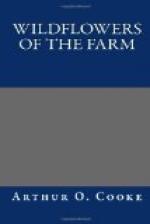At the top of the stem is a cluster of very handsome rosy-red flowers. Each blossom is star-shaped when fully open, and generally has twelve petals.
[Illustration: House Leek.]
If we could see the roots we should find them very thread-like or fibrous, like those of other flowers we have been looking at to-day. I do not think I can very well show you the roots, however; we should have to pull up a plant, and that would not please Ben, the cowman, at all. There is a belief in country places that it is bad luck to disturb the Houseleek—that someone in the house on which it grows is sure to die soon afterwards. Certainly the plant is not growing on a house here—only on the calves’ cot. Still, if any misfortune should happen to the calves we might be blamed by Ben. Besides, it would be a pity to disturb so handsome a plant, would it not?
We have spent some time in looking at these flowers on the walls and roof because we think them very wonderful. We see how little soil they can have in which to grow, and how, in dry weather, they can have very little moisture either. Yet the leaves of several of them are thick and fleshy, and the flowers of some are large and beautiful. What could be more handsome than the blossoms of the Wallflower, the Red Valerian, and the Houseleek?
CHAPTER IV
THREE HANDSOME WEEDS
At the end of the drive, near the front door, another white gate leads to the “nag” stables, where Mr. Hammond keeps the two horses which he rides and drives. Billy, the old brown pony, has a little stable of his own close by, and further on are the granary and the poultry yard.
Perhaps you have heard the saying, “Ill weeds grow apace.” It is certainly a true one, for most of the plants which we call weeds grow quickly and well wherever they are allowed to remain. We shall not have far to look for the three weeds which I want to show you this morning. The first of them is the Stinging Nettle. It grows round the wood-pile in the middle of the poultry-yard, and there are great clumps of it beside the hedge which divides the poultry-yard from the kitchen garden.
It is really a very handsome plant, though you may not have thought so before. Look how tall and straight the stems are, and how evenly and regularly the dark green pointed leaves grow from it. They grow in pairs, on opposite sides of the stem, and are serrated. There is something rather unusual about the stem of the Nettle which we will notice at once. I have brought out a pair of thick leather gloves, so that we can pick a stem without being stung.
You know what shape the trunks of trees are. Round? Yes; round or nearly so. So are the stems of most plants; the stems of the Red Valerian are round. The stem of the Nettle, however, is square, or if not perfectly square, it has four distinct sides. Perhaps you had never noticed this before, for the Nettle is certainly not a plant with which one cares to have very much to do.




